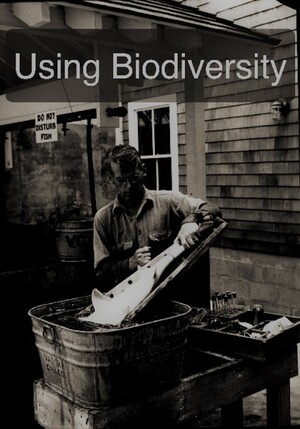Experiments with marine organisms and their embryos started to become increasingly important work in the mid-1890s. While experimental biologists today may work with one or another experimental organism as a model to understand fundamental biological processes, early experimental work addressed questions using an array of different marine organisms. One remarkable biologist to look to for examples of such work is the embryologist-turned-geneticist Thomas Hunt Morgan. Morgan, from the late 1890s and into the first decade of the 20th century, conducted experiments using a variety of marine organisms at the MBL to understand inter-species hybrids, regeneration, and self-fertilization. While Morgan is best known for his groundbreaking work on the genetics of the fruit fly Drosophila melanogaster in the 1910s and 1920s, his earlier work shows a rather eclectic interest in the processes organismal development and organic generation and regeneration.
Survey and Collecting
Report Upon the Invertebrate Animals on Vineyard Sound and Adjacent Waters
- Verrill, Addison Emery and Sidney Irving Smith. Report Upon the Invertebrate Animals on Vineyard Sound and Adjacent Waters. 1873.
- -- A biological survey of the waters of Woods Hole and vicinity
- Sumner, Francis B. "The Biological Laboratory of the Bureau of Fisheries at Woods Hole, Mass. Report of Work for the Summer of 1904." (1905): 566-572.
- Sumner, Francis Bertody, Raymond Carroll Osburn, Leon Jacob Cole, and Bradley Moore Davis. A biological survey of the waters of Woods Hole and vicinity. Vol. 31. Govt. Print. Off., 1913.
- -- Methods for obtaining and handling marine eggs and embryos
- Costello, Donald P., and Catherine Henley. Methods for obtaining and handling marine eggs and embryos. Marine Biological Laboratory, 1957.
Experiment
- Morgan, Thomas Hunt. “Experimental studies on echinoderm eggs.” Anat. Anz. 9 (1893): 141–52.
- Morgan, Thomas Hunt. "A Study of Metamerism." Quarterly Journal of Microscopical Science 37 (1895): 395.
On Regeneration
- Morgan, Thomas Hunt. "An Analysis of the Phenomena of Organic 'Polarity'." Science 20 (1904): 742–8.
- ———. "An Attempt to Analyze the Phenomena of Polarity in Tubularia." Jour. Exp. Zool. 1 (1904): 587–91.
- ———. "Experimental Studies of the Internal Factors of Regeneration in the Earthworm." Arch. Entw.-Mech. 14 (1902): 562–91.
- ———. "Experimental Studies of the Regeneration of Planaria Maculata." Arch. Entw.-Mech. 7 (1898): 364–97.
- ———. "The Factors That Determine Regeneration in Antennularia." Biol. Bull. 2 (1901): 301–5.
- ———. "Further Experiments on the Regeneration of the Appendages of the Hermit-Crab." Anat. Anz. 17 (1900): 1–9.
- ———. "Further Experiments on the Regeneration of the Tail of Fishes." Arch. Entw.-Mech. 14 (1902): 539–61.
- ———. "Further Experiments on the Regeneration of Tissue Composed of Parts of Two Species." Biol. Bull. 2 (1900): 111–9.
- ———. "Further Experiments on the Regeneration of Tubularia." Arch. Entw.-Mech. 13 (1902): 528–44.
- ———. "Growth and Regeneration in Planaria Lugubris." Arch. Entw.-Mech. 13 (1901): 179–212.
- ———. "The Internal Factors in the Regeneration of the Tail of the Tadpole. (with S. E. Davis)." Arch. Entw.-Mech. 15 (1902): 562–91.
- ———. "Notes on Regeneration." Biol. Bull. 6 (1904): 159–72.
- ———. Regeneration. Biology Series. New York: Columbia Univ., 1901.
- ———. "Regeneration and Liability to Injury." Zool. Bull. 1 (1898): 287–300.
- ———. "Regeneration and Liability to Injury." Science 14 (1901): 235–48.
- ———. "Regeneration in Allolobophora Foetida." Arch. Entw.-Mech. 5 (1897): 570–86.
- ———. "Regeneration in Bipalium." Arch. Entw.-Mech. 9 (1900): 563–86.
- ———. "Regeneration in Planarians." Arch. Entw.-Mech. 10 (1900): 58–119.
- ———. "Regeneration in Teleosts." Arch. Entw.-Mech. 10 (1900): 120–34.
- ———. "Regeneration in the Egg, Embryo, and Adult." Am. Nat. 35 (1901): 949–73.
- ———. "Regeneration in the Hydromedusa, Gonionemus Vertens.". Am. Nat. 33 (1899): 939–51.
- ———. "Regeneration in Tubularia." Arch. Entw.-Mech. 11 (1901): 346–81.
- ———. "Regeneration of Proportionate Structures in Stentor." Biol. Bull. 2 (1901): 311–28.
- ———. "Regeneration of the Appendages of the Hermit-Crab and Crayfish." Anat. Anz. 20 (1902): 598–605.
- ———. "Regeneration of the Heteromorphic Tails in Posterior Pieces of Planaria Simplicissima." Jour. Exp. Zool. 1, no. 385–91 (1904).
- ———. "Regeneration of the Leg of Amphiuma Means." Biol. Bull. 5 (1903): 293–6.
- ———. "Regeneration of Tissue Composed of Parts of Two Species." Biol. Bull. 1 (1899): 7–14.
- ———. "Regeneration: Old and New Interpretations." Biol. Lect., Woods Hole, 12th (1900): 185–208.
- ———. "Some Factors in the Regeneration of Tubularia." Arch. Entw.-Mech. 16 (1903): 125–54.
- ———. "Some Problems of Regeneration." Biological Lectures, Woods Hole (1898): 193–207.
- Morgan, Thomas Hunt. "Self-fertilization induced by artificial means." J Exp Zool 1 (1904): 135-178.
Supply and SaleSupply
- “The Marine Biological Laboratory, Ninth Report for the Years 1896–1899 and Statistics of the Years 1900–1902.” The Biological Bulletin (1902): 173.
- “The Marine Biological Laboratory, Thirty-Third Report for the Year 1930—Forty-Third Year.” The Biological Bulletin 61 (1931): 13.
Sale
- Pauly, Phil. Biologists and the Promise of American Life: From Meriwether Lewis to Alfred Kinsey. (Princeton U. Press, 2000): 187.
- Lipshitz, Howard. “From Fruit Flies to Fallout: Ed Lewis and His Science.” Developmental Dynamics 232 (2005): 529–46.
- “The Marine Biological Laboratory, Seventieth Report, For the Year 1967—Eightieth Year.” The Biological Bulletin 135 (1968): 72.

